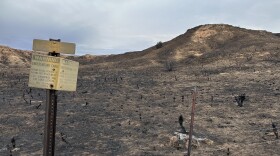When the Nebraska State 4-H Campground opened in the summer of 1963, nestled within seven acres of the Nebraska National Forest, hundreds gathered outside the lodge in their Sunday best. The spring-fed Middle Loup River cleaved the valley below. The ballroom glistened inside. And the state 4-H manager sang “Bless This House” beneath the pines.
“It is impossible to acknowledge all of the contributions made by 4-Hers, leaders, parents, county agents and friends in all parts of the state,” E.W. Janike, dean of extension at the University of Nebraska, told the crowd. “Because of their efforts, the state 4-H camp is no longer a dream.”
Nearly 60 year later, fire ripped through the campground on Sunday afternoon. That dream now smolders beneath a rat’s nest of twisted sheet metal and ashen debris.
Where the Eppley Lodge once stood, the late Omaha philanthropist Eugene Eppley remains, frowning in bas relief on a commemorative plaque that survived the fire.
Another survivor is the giant four-leaf clover, still green as grass, painted on the concrete outside. Lamps that once ushered visitors through the trees now droop from their posts, disfigured by the heat. A metal folding chair nests precariously atop a blackened cedar. Thirteen red tin roofs, spread like blankets across the sand, hint at the timber-frame cabins that once stood beneath them.
The 4-H clover symbol remains as a reminder of the activities that took place at the camp over the course of some sixty years.
According to United States Forest Service spokesperson Travis Mason-Bushman, the Bovee Fire ignited roughly three miles south of the Bessey Ranger District office near Halsey, population 63, around 1:39 p.m. All campers and the entire town of Halsey were evacuated.
Gusty southern winds then marshaled the inferno north and west through the hand-planted forest -- fueled by severe drought and bone-dry underbrush -- before wayward embers drifted further north across Highway 2 and set the neighboring ranchland ablaze.
“Everybody pulls together”
Mike Moody, a beloved Sandhiller and Purdum Volunteer Fire Department assistant chief, suffered a heart attack and died while chasing the fire into open grassland.
In addition to the 4-H campground and the Scott Lookout Tower, once perched 50 feet above the forest floor, the fire has so far consumed roughly 19,000 acres of both federal and private property. As of late Wednesday night, a crew of nearly 200 emergency responders -- under the command of Rocky Mountain Complex Incident Management Team -- had rendezvoused near the forest, and the fire was 94-percent contained.
Mike Moody, volunteer firefighter and local business owner, died of a heart attack fighting the Bovee Fire in Central Nebraska.
“How the fire developed? That's chemistry and physics. An ATV is hot, rolls over, gas catches fire, whatever,” said Phil Daniels, incident commander trainee. “How it's put out, though, is really about psychology. Everybody pulls together--everybody. The focus is really to get this community back to a certain amount of normality.”
Though USFS personnel are still awaiting the results of an official investigation, numerous sources -- including first responders and federal firefighters -- said the fire was likely accidental and sparked by an all-terrain vehicle. Popular amongst ATV enthusiasts, the Bessey Ranger District maintains roughly 36 miles of trail for off highway vehicles.
“Not everybody can ride a horse,” said Russell Licking, a volunteer firefighter from nearby Thedford. “That was the draw. That's why people came to the forest.”
As the fire developed, State 4-H Program Leader Kathleen Lodl texted back and forth with USFS personnel. When the news first trickled in, she hadn’t considered the devastation to follow. In years past, in fact, the camp housed volunteers fighting other fires in the Sandhills.
“This was different,” she said.
Her cell phone lit up with updates as the fire scorched the camp. First the cabins. Then the lodge. The education center, too. The only 4-H staffer on site had already evacuated, as had the 14 students visiting from the University of Nebraska-Lincoln.
No one was hurt. But what so many considered their second home, even their spiritual home, has been reduced to ash scattering in the wind.
“My first thought was thankfulness that we had no campers onsite and that all our staff were safe,” Lodl said. “I also thought about firefighters and first responders who were working so hard on our behalf. We are so very grateful for all of them.”
David Haskell, a volunteer firefighter from nearby Anselmo, was reassigned to the 4-H camp after first manning a chemical building at the Charles E. Bessey Tree Nursery. When he and his truck mate turned into the camp, he said, “everything was just black.” The valley below was a bowl of sand. The cabins were missing. The hills were naked.
The pair uncoiled their hose and began soaking the north face of the Eppley Lodge, desperate to save one of central Nebraska’s most iconic structures. More than 30,000 campers had passed through the building. Prom dates once danced beneath the wooden rafters. Newlyweds and ballet dancers, too. But nearly as soon as Haskell opened the nozzle, the futility of their efforts sunk in. The balcony was already engulfed in flames. The roof, too. They reeled the hose back in. Haskell shot a quick cell phone video from the passenger seat as they evacuated.
“I just wish there was something more that could have been done,” he said.
“Like a family member dying”
By Monday morning, word of the fire had spread online. Video footage from passersby on Highway 2 showed a massive plume of gray-black smoke. One photo showed the lodge’s towering stone fireplace surrounded by rubble. Those who hadn’t visited the forest in years were suddenly overwhelmed with memories of summer camp: s’mores and ghost stories and slip n’ slides.
“You know, ‘Ralph Ralph, strong and able, get your elbows off the table,’ That kind of thing,” said Katherine (Horst) Lucky, who grew up in nearby Halsey. “It was an exciting time.”
Horst’s father Gene, an independent contractor, literally built the campground. And then he built most of it again after a lightning fire razed eight of the cabins and roughly a third of the forest just two years later. Her mother, Eleanor, managed the campground for its first quarter century.
When news of the Bovee Fire found Horst in Arizona, where she lives now, “It was like a family member dying,” she said. “It really was.”
The wreckage extends far beyond the 4-H camp itself. Driving through the forest Tuesday afternoon, district ranger Julie Bain stared out the back window in disbelief.
Hills once thick with ponderosa pine and eastern redcedar were mottled with ash and sand. Now stripped to the bone, the forest revealed its artifice: one row of trees after the next after the next, each of them perfectly spaced and straight as an arrow. With every bend in the road, a gasp. A sigh. Some gallows humor to lighten the load.
“Well, we don’t have to burn piles this year,” joked Tedd Teahon, district fire management officer. “We’ve overachieved.”
A hand-planted forest
When President Theodore Roosevelt established the Nebraska National Forest in 1902 in the heart of the Nebraska Sandhills, there wasn’t a standing forest at all. And that was the point. Area ranchers needed a local timber supply. A little rain wouldn’t hurt, either. (Though now refuted, scientists had long alleged that tree planting could ameliorate the arid climate.)
After years of tireless campaigning, botanist Charles Bessey at the University of Nebraska convinced the Roosevelt Administration that a forest could be grown in the so-called “Great American Desert.” And he was right.
Today, the Bessey Ranger District at the Nebraska National Forest, boasting more than 20,000 acres of trees, is the largest hand-planted forest in the western hemisphere.
For many, the forest is a living monument, a green symbol of Nebraskan resolve. It’s a reminder of their uncle who helped plant the trees for the Civilian Conservation Corps, or their grandfather, who worked for the nursery.
For others, however, especially as the scientific understanding of grassland ecology has improved, Bessey’s wild idea is now a case study in hubris, a living manifestation of the settler-colonialist mindset. Some have gone so far as to call for its removal. Bain, for her part, is on the fence.
“I have been somewhat cavalier about the trees, because they shouldn't be here. But actually seeing what that looks like when the trees aren't here,” she said, still shaken after the drive. “It's a sinking feeling.”
Whether or not the forest will be replanted, and whether or not the campground will be rebuilt, are both lingering questions. So far, neither Bain nor Lodl have the answers.
Remembering a Superhero
In the meantime, crews continue to lasso the fire, and campers continue to mourn. The school kids who waited for the bus each morning outside The Mercantile in tiny Purdum, Nebraska, 15 miles north of the forest, remember owner Mike Moody, who passed while fighting the fire.
The very next morning, his shop was plastered with notes and letters. One of them showed Moody in overalls and cape. “Superhero of the Sandhills,” it said.
His loved ones, many of whom also attended the 4-H camp, huddled around their kitchen table in Purdum, to share memories.
“He was one of the most fun loving guys you could ever be around,” says Cheryl Moody, his wife.
“He had good overalls and work overalls, but no matter what, unless it was a funeral or a wedding, it was bib overalls,” she added with a grin.
They remembered the notes Moody scribbled on the Copenhagen tins he kept in those overalls and eventually discarded around the mercantile he ran down the street: How many bags of feed, what kind of mix, who ordered it, when they’d come back. He never forgot a customer’s name, they said, and they rarely forgot his. He loved nature, and he loved the Sandhills in their most primitive, wild form
And when he was paged for extra manpower at the forest, Moody, who’d been fighting fires in the Sandhills since he was old enough to carry a hose, dropped everything and hit the road. He always did.
“It's like we lost our whole community,” his daughter Hollie said, fighting back tears. “Everything good around here is gone.”
Copyright 2022 KCUR 89.3. To see more, visit KCUR 89.3. 9(MDA4OTAxNzAzMDEzMjc0MTc2MzA5ZDZlMw004))






